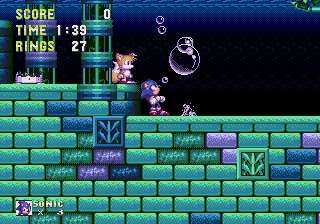Oxygenated Underwater Bubbles
No matter how exactly they're made underwater, and how they could contain enough oxygen to allow the character to breathe longer...
You just have to not worry about it too much, because chances are, you'll need these bubbles either way to keep yourself from drowning when you're underwater.
If the character is somehow able to breathe underwater in ways that should actually be impossible for them to do (such as a human character with an overall lack of any scuba gear), then you have Super Not-Drowning Skills, instead.
Common in Video Games where there's no other way to survive underwater besides surfacing for air. Compare with Artificial Gill.
Examples of Oxygenated Underwater Bubbles include:
Action Games
- They pop up in an underwater level in Karoshi 2.0; of course, this being Karoshi, you're supposed to avoid them so that you can die.
Action Adventure Games
- These could be gotten from oysters in Ecco the Dolphin, although sometimes you would get a poisoned bubble if you weren't careful.
- There were also bubble vents available in some places, especially in Defender.
- Although the oyster ones are deceptive—they don't give you more air. They restore health, instead. Which, if you had a corridor full of oysters, could in theory serve a similar function as you restore health faster than it drains, but that doesn't ever happen so you'd better find the surface.
- There were also bubble vents available in some places, especially in Defender.
- The Legend of Zelda Skyward Sword has these for its underwater segments, as well as poisoned purple bubbles that drain a ton of your breath meter, almost assuring you'll drown if you don't surface ASAP.
Platform Games
- Forty Winks has underwater vents that spew breathable bubbles. Just running through them is not enough, however; you have to linger on them to get a full-sized gulp of air.
- In Banjo-Kazooie, one area in Clanker's Cavern has a huge pit you need to swim into, but it's very, very deep. A friendly fish named Gloop appears down there who spits out oxygenated bubbles. He appears nowhere else, however, making him a Unique Helpful Mook.
- Kirby Mass Attack has those bubbles since it's one of the few games where Kirby cannot breathe underwater infinitely.
- Rayman 2 normally uses Blue Lums to restore air underwater, but Carmen the Whale produces air bubbles that work identically. Rayman Revolution replaces the Blue Lums with bubble vents.
- Sonic the Hedgehog: Every 2D game (plus the Sonic Adventure Series, Sonic Colors, and Sonic Generations) that contains an Under the Sea, Underwater Ruins, or Down the Drain level.
- Super Mario 64: While coins somehow gave you some of your air/health back, inhaling an air bubble would fill it up completely. Super Mario Galaxy and its sequel also have air bubbles, but ironically, Super Mario Sunshine only has them appear in one specific instance: the battle against Eely-Mouth.
- In the Mickey Mouse game World of Illusion, Mickey and/or Donald travel underwater inside a bubble that surrounds their body.
MMORPGs
- Some areas in World of Warcraft have fissures which spew enough oxygen for your character to breathe underwater.
Rougelikes
- Tales of Maj'Eyal has a few underwater levels with stationary (and depletable) bubbles that you have to travel between to avoid suffocation.
Wide Open Sandbox
- Brain coral in Subnautica emit bubbles of breathable air that somehow automatically refill your air tanks if you're wearing any, or just help you hold your breath longer if you aren't.
Real Life
- Real Life example: some types of diving beetle (and one diving spider) trap a thin layer of air against their bodies and use these to breathe. The spider even makes an underwater web to trap air in, allowing it to live most of its life underwater.
This article is issued from Allthetropes. The text is licensed under Creative Commons - Attribution - Sharealike. Additional terms may apply for the media files.
